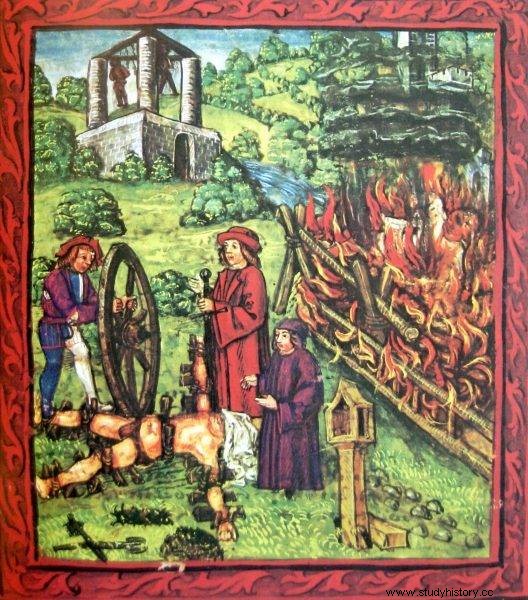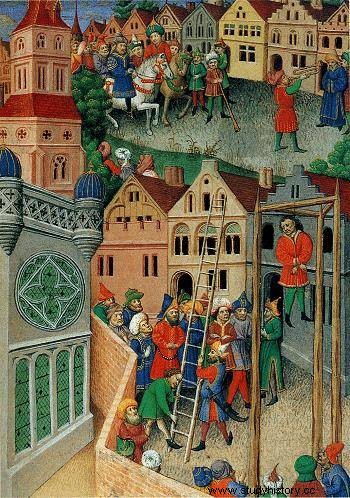A nuisance neighbor? Unrequited love? Trouble in business? Centuries ago, shocking solutions to problems were used - for example, magical artifacts ... from under the gallows.
Sometimes a desperate person clings to solutions that make others creep. But what if you are a professional thief and fear of being caught paralyzes your movements? Or do you live off the market of beer and booze that nobody wants to drink? Change profession? In practice, it is not always that simple ... Therefore already in the Middle Ages many "reliable" methods were developed for this type of ills . However, they required a visit to the city gallows, to the house of an executioner or other local pariah. And a little bit of knowledge about magic recipes and spells.
A reliable remedy for problems - the rope from the gallows
The hanging rope was once considered a miracle cure for numerous ills . All over Europe believed in its extraordinary power. A small piece of such a rope could bring good luck and protect against the cold. It was also supposed to be effective in treating just about everything. He provided the farmer with excellent yields. It was enough just to tie it to the shoulder or sew it up in the clothes. It was also believed that could be helpful in finding stolen items. In 1535, a hatter from Munich tried to buy a piece of hangman's rope from a local executioner. He was counting on her to help him find the hats that had fallen to the thieves.

Moreover, the splinters from the gallows and the scaffold, elements of the wheel used to execute criminals, were magical.
Moreover, splinters from the gallows and the scaffold, elements of a wheel used to kill criminals or a nail pulled out of a convict's head woven into such a wheel, were magical. The blood of the decapitated unfortunates was also an extremely valuable loot.
Lucky thumb
The fragments of the bodies of the executed were also very popular in the past. An extremely marketable "commodity" were the cut off of hangmen's fingers, hands, genitals, hair or other parts of the corpse . The bones, skin and fat of the condemned man could act as talismans or enhance the effects of medicaments. Thieves especially hunted the thumbs of their hanged colleagues believing that they will bring them happiness. Often, on the second day after the execution, the bodies were hanging from the gallows in a state of advanced disassembly ... Events from the mid-seventeenth century echoed loudly. The wife and son of the Munich executioner desecrated the corpse of a decapitated infanticide at night, cutting out her heart . According to official investigations, it was intended to be used to make popular amulets.
Cut off hands, fingers or dug out bones of villains also ended up under ordinary thatch, where they were cleverly hidden, for example in a bed or a chest. It was hoped that they would protect or bring happiness. Interrogated at the end of the 17th century in the vicinity of Kowalewo Pomorskie, the alleged witch testified that for her secret practices she used a hanged man's head found under a gallows. She believed that pieces of corpses brought from the place of execution could be helpful in selling beer and booze. Of course, it was not necessary to soak a complete skull in the prepared drink. It was enough to chip off a small piece of it or crush the bone into powder.
A corpse's head bringing rain
A loud scandal broke out in Bydgoszcz in 1669, when one of the local bakers was accused of adding powdered human bones, brought from under the gallows, to diluted bread. They were supposed to increase its sales. Of course, properly crafted and enchanted bones also had the power to harm . When added stealthily to brewed beer, they effectively spoiled the entire production.

An extremely salable "commodity" were the severed fingers, hands, genitals, hair and other fragments of the corpse.
The corpse's head could also be used to cause inclement weather. It had to be dipped very carefully in the water to make it rain. However, it had to be done in moderation. Inattention could have caused a storm, as it was supposed to happen to a certain Pomeranian boy in the early 17th century. It was also believed that the hangman's head, his skull, and the brain itself had healing properties.
The cut off hand of the executed criminal could be kept under a home thatched roof, bearing in mind, however, that if a new house was built, you should take it with you. Otherwise, the positive energy stopped working. When it was placed under the manger in the stable, it guaranteed the health of the horses. As testified at the end of the 16th century, a resident of the former Ducal Prussia testified that such a hand also ensured a good harvest of grain and protected against the elves . She could help in brewing beer, but also bring in bad weather. Thieves also hunted it, believing that thanks to it they would overcome every, the most sophisticated castle. On the other hand, when it was set on fire, the thieves' jump was successful.
A scrap of the "deadly" shirt
People also reached for pieces of clothes from executed people, although these were often difficult to access. The more valuable elements of the convict's outfit usually fell into the hands of the executioner and his assistants. The victim went to the gallows, scaffold or wheel only in a special, "deadly" shirt. However, if you managed to get a scrap of it, especially a bloody one, you could add it, for example, to the beer you sell. Of course, to increase its popularity. This was the opinion of, for example, two women from Rewel (today Tallinn, the capital of Estonia), to whom in the 16th century an assistant of a local executioner delivered fragments of clothes torn from a thief hanging on a gallows. However, it was not understood by the authorities. All three were exemplarily flogged.
Other items related to the convicts could also have magical values. At the end of the 16th century, a woman testified in Kalisz that water from the vessel, which had previously been used to drink the condemned man on his way to execution, poured water over the apartment. At the same time, she loudly wished that there would be as many people eager for the beer brewed in the building as the number of onlookers followed the unfortunate man that day. Of course, on a later questioning, she swore they were just jokes.
Magic Mandrake
It was also common practice to look for various herbs under the gallows. Mandrake was particularly popular, in Poland it was usually replaced with a poisonous shout (belladonna, belladonna). Both perennials possess hallucinogenic and narcotic properties. According to a once popular superstition dating back to the end of the Middle Ages, they grew out of the urine or semen of a dying man on the gallows of a hanged man. Possibly from the last tears of innocently hanged. Supposedly, for this reason, the root took a human, headless shape. Torn from the ground, it made deadly sounds resembling the scream of a man. If it had been punctured, it would leak a fluid similar to blood.
To retrieve the mandrake, it was recommended to tie the dog to it by the tail and, from a safe distance, with its ears plugged, encourage the animal to pull the root out of the ground . If you have become the happy owner of an authentic mandrake, you should take care of it. For example, wash weekly, preferably with warm beer, wine or milk and wrap in a cloth. Root was able to repay it, becoming an almost universal remedy for life's problems.

To retrieve the mandrake it was recommended to tie the dog by the tail to it
The beer in which the mandrake was dipped not only tasted better, but also gained magical qualities. The cattle, drunk with such a decoction, became resistant to all diseases and magic. Mandragora also helped women in childbirth, treated various ailments, including fever, foretold the future, was an aphrodisiac, she also had, among others, bring respect and money. Some fortunate people claimed to find them at the root every morning. Mandrake provided girls with a faster marriage, treated women for infertility, and opened all locks for thieves.
A drink with an addition
The belief in the magical qualities of gallows artifacts persisted for a very long time. Especially in the countryside and in small towns, where it was still present in the 19th century. Even in the era of "coal and steel" in many taverns there was still a vessel with spirits in the back, in which a small piece of gallows rope was soaked. If the innkeeper wanted the customer to taste the drink he served, all he had to do was pour a drop of this wonderful cordial into the glass imperceptibly ...
Bibliography:
- Bohdan Baranowski, The oldest witchcraft trials in Kalisz , Lubiln-Łódź 1951.
- Werner Danckert, Unehrliche Leute. Die verfemten Berufe , Bern-München 1963.
- Paweł A. Jeziorski, Places of execution of the death penalty, corporal punishment and punishment in honor in Kujawy in the Old Polish period , Ziemia Kujawska, vol. 25:2016, pp. 5-38.
- Jutta Nowosadtko, Scharfrichter und Abdecker. Der Alltag zweier “unehrlicher Berufe” in der Frühen Neuzeit , Paderborn-Müchen-Wien-Zürich 1994.
- Jacek Wijaczka, Magic and witchcraft. Hunt for witches and sorcerers in Ducal Prussia in the early modern times , Toruń 2008.
- Jacek Wijaczka, Trials for witchcraft before the court of the mayor of Kowalewo (Pomeranian) in the 17th-18th centuries , Zapiski Historyczne, vol. 32:2017, issue 2.s 101-119.
